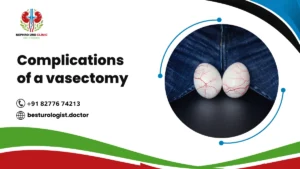They start small—grainy little minerals with big plans. Kidney stones form when your body’s balance of fluids, salts, and minerals goes off track, creating tiny crystals that can grow, move, and hurt. For anyone who’s felt that sharp, sudden jolt of kidney stone pain, you know it’s not just discomfort—it’s debilitating. So, how to get rid of kidney stone pain becomes more than a question. It becomes urgent. Let’s begin by understanding what’s happening inside your body and how relief can be within reach.
What is a Kidney Stone?
Kidney stones are hard deposits made of minerals and salts that form in the kidneys. They vary in size, with some being as small as a grain of sand and others growing large enough to obstruct the urinary tract, leading to severe pain. The most common types of kidney stones include:
- Calcium Stones: These are the most common and are typically made of calcium oxalate.
- Struvite Stones: These stones form in response to infections, such as a urinary tract infection.
- Uric Acid Stones: Uric acid stones develop when the urine is too acidic, often due to high consumption of animal protein.
- Cystine Stones: These rare stones form in people with a hereditary disorder called cystinuria, which causes the kidneys to excrete too much cystine.
Understanding the type of stone you’re dealing with is crucial in developing an effective strategy to reduce the risk of kidney stones and prevent their recurrence.
Kidney stones – what is it? And what causes it?
- Kidney stones are hard deposits of minerals and salts that form inside the kidneys when urine becomes too concentrated. This environment allows substances like calcium, oxalate, and uric acid to crystallize and stick together, forming stones of varying sizes.
- One major cause is dehydration, which reduces urine volume and makes it easier for crystals to form. Individuals who don’t drink enough water or live in hot climates are particularly at risk.
- Diet plays a significant role, especially high intake of sodium, animal protein, and oxalate-rich foods like spinach or chocolate. These can raise the levels of stone-forming substances in the urine.
- Certain medical conditions and medications—such as hyperparathyroidism, urinary tract infections, or diuretics—can change urine composition and increase the likelihood of stone formation.
- Family history and genetics also contribute, with those having a relative with kidney stones being more likely to develop them. This makes prevention strategies even more critical for such individuals.
- Knowing the root cause is essential to determine the best way to get rid of kidney stone pain. Treatment may vary based on the stone type—calcium, uric acid, struvite, or cystine—and understanding this guides more effective relief.
A Basic Understanding of Kidney Stone Pain
- Kidney stone pain often begins suddenly and is typically felt in the lower back or side, just below the ribs. The pain can be intense, cramping, and may come in waves as the stone moves through the urinary tract.
- As the stone travels, the pain may shift toward the abdomen or groin. This happens because the stone irritates the ureter—the narrow tube connecting the kidney to the bladder—causing muscle spasms and pressure buildup.
- The size of the stone doesn’t always reflect the intensity of pain. Even a tiny stone can cause excruciating discomfort if it gets lodged in a tight spot or triggers inflammation.
- Nausea, vomiting, and blood in urine often accompany kidney stone pain, especially during acute attacks. These symptoms arise as the body reacts to the obstruction and internal irritation caused by the stone.
- For those wondering how to get rid of kidney stone pain, it’s important to manage both the physical symptoms and the underlying cause. Quick relief often involves a combination of hydration, pain medication, and sometimes medical intervention.
- The best way to get rid of kidney stone pain depends on how far the stone has traveled, its size, and your overall health. In some cases, passing the stone naturally is possible, but persistent pain or infection requires immediate medical care.
Common Characteristics of Kidney Stone Pain
Kidney stone pain is one of the most intense and severe types of pain. It typically occurs when a stone moves through the kidney or the urinary tract, blocking the flow of urine. The pain varies depending on the size and location of the stone, but there are common characteristics that can help identify this condition.
- Sharp, Sudden Pain (Renal Colic): Kidney stone pain often starts suddenly and is typically sharp in nature. It usually begins in the back or side and can radiate to the lower abdomen and groin. This type of pain, known as renal colic, can come in waves, with intensity increasing and decreasing over time. The onset of the pain can feel like an emergency, which is why people often seek immediate medical help.
- Pain During Urination: When the kidney stone moves into the ureter (the tube that connects the kidney to the bladder), it may cause a dull ache or sharp pain while urinating. This occurs as the stone passes through the narrow ureter, causing irritation and discomfort. The pain can be intense enough to cause a burning sensation or discomfort throughout the lower abdomen and pelvic region.
- Radiating Pain in the Groin or Lower Abdomen: As the stone progresses through the urinary tract, the pain may radiate to the groin or lower abdomen. This happens because the stone moves closer to the bladder, and the pain sensation is felt along the nerve pathways connected to the lower abdomen. The pain may become more localized, and it can mimic symptoms of other conditions like appendicitis or a hernia.
- Intermittent Pain (Pain Worsens and Eases): One distinguishing feature of kidney stone pain is its intermittent nature. The pain often worsens and then temporarily eases as the stone shifts within the urinary tract. These fluctuations in pain intensity can be confusing, as it may feel like the pain is coming and going, but the underlying problem remains.
- Pain Accompanied by Nausea and Vomiting: Kidney stones are often associated with nausea and vomiting, particularly during episodes of intense pain. The body reacts to the pain by causing the digestive system to become upset. This is why many people with kidney stones find that their discomfort extends beyond just the pain in their back or abdomen and includes gastrointestinal distress as well.
- Pain That Comes in Waves: The characteristic pain from kidney stones tends to come in waves, with periods of sharp, intense pain followed by moments of relief. This can last from a few minutes to several hours. The frequency of these waves can vary, and in some cases, the pain might persist until the stone moves or passes completely.
- Pain That Does Not Relieve with Changing Positions: Unlike other types of abdominal or back pain, kidney stone pain is typically not relieved by changing positions or resting. This is because the pain is caused by the obstruction or irritation of the urinary tract, not muscle tension or spasms. Moving around or lying down may not alleviate the discomfort, which is a key indicator that the issue could be a kidney stone.
- Hematuria (Blood in Urine): Another common characteristic of kidney stones is the presence of blood in the urine, known as hematuria. This occurs when the stone causes small tears or abrasions in the lining of the urinary tract. The blood may not always be visible to the naked eye but can be detected in a urinalysis. The presence of blood often exacerbates the discomfort felt during urination and can increase the overall pain.
- Frequent Urination or Urgency to Urinate: Individuals with kidney stones may also experience the sensation of needing to urinate frequently or urgently. This is often because the stone may cause irritation in the bladder or ureter, leading to discomfort and a constant urge to urinate. In severe cases, this urgency may occur even when little or no urine is passed.
- Pain Associated with Fever and Chills: In some cases, kidney stone pain can be accompanied by fever and chills, especially if the stone causes an infection or if it obstructs the urine flow. This combination of symptoms often signals a more serious condition, such as a urinary tract infection (UTI), and requires prompt medical attention. A fever with kidney stone pain should not be ignored, as it may indicate an infection that could lead to further complications.

Treatment for Emergency Situations
- Signs of Emergency – Severe pain that does not subside, inability to urinate, or fever with chills are warning signs of a serious complication. These situations require urgent hospital intervention.
- Immediate Medical Action – Emergency care includes strong intravenous pain medication, fluids to help pass the stone, and antibiotics if infection is suspected. Such cases demand immediate professional attention rather than home remedies.
- Surgical Solutions – In certain situations, procedures such as ureteroscopy or percutaneous nephrolithotomy are performed to remove or break up large stones. These are among the most effective treatment options for kidney stones when obstruction or infection is present.
- Why Speed Matters – Knowing how to get rid of pain of kidney stones in emergencies is about acting fast. Delays can result in sepsis, permanent kidney damage, or severe urinary tract complications. Prompt treatment ensures both pain relief and preservation of kidney function.
Treatment for Non-Emergency Situations
- Small Stone Management – If the stone is small and pain is manageable, doctors often recommend increased water intake to help flush it out naturally. Alpha-blockers may be prescribed to relax the ureter muscles.
- Dietary Adjustments – Reducing sodium, avoiding high-oxalate foods, and balancing calcium intake can prevent further stone growth. These steps are part of kidney stone non-surgical treatment strategies.
- Home Care and Monitoring – Applying heat to the affected area and using over-the-counter pain relief can help manage symptoms. Understanding how to get rid of kidney stone pain naturally is valuable for avoiding unnecessary medical intervention.
- Long-Term Perspective – Passing a stone can take days or weeks. Monitoring symptoms is essential, as worsening pain or urinary issues may require reevaluation. These gentle approaches often represent the best way to get rid of kidney stone pain in stable cases.
Pain Relief Remedies for Kidney Stones
- Stay well-hydrated to flush out the stone naturally. Drinking 2.5 to 3 liters of water a day can help push the stone through the urinary tract. Add lemon juice to your water, as citric acid may break down small stones and prevent new ones from forming.
- Use over-the-counter pain relievers for temporary relief. Medications like ibuprofen or naproxen help reduce inflammation and dull the sharp pain while the stone is passing. However, these should be taken under guidance, especially if you have kidney or liver issues.
- Apply heat to the affected area. A warm compress or heating pad on the lower back or abdomen can relax the muscles around the kidneys and ureters. This can reduce spasms and offer mild, temporary comfort.
- Try prescribed alpha-blockers if recommended by a doctor. Drugs like tamsulosin help relax the ureter, making it easier for the stone to pass. This can shorten the duration of pain and decrease the need for surgical intervention.
- Avoid high-oxalate foods and salty meals while managing symptoms. Spinach, beets, nuts, and processed foods can worsen the condition and slow recovery. A low-sodium, kidney-friendly diet supports natural healing and is part of how to get rid of kidney stone pain efficiently.
- Consult a healthcare provider if pain persists or worsens. While many stones pass on their own, some require medical treatment like shock wave therapy or ureteroscopy. Delaying professional help can complicate the condition and make it how to get rid of pain of kidney stones safely.
When to Go to the Doctor
- Warning Symptoms – Seek immediate medical care for unbearable pain, fever, chills, or inability to urinate. Blood in urine and persistent vomiting are also red flags.
- Diagnostic Evaluation – Medical imaging helps identify the stone’s size and location, guiding decisions on whether kidney stone non-surgical treatment or surgery is needed.
- Preventing Complications – Delaying treatment can lead to severe infections or irreversible kidney damage.
- Best Practice – Consulting a doctor ensures you get accurate advice on how to get rid of pain of kidney stones and choose among the safest treatment options for kidney stones based on your condition.
Managing the Kidney Stones at Nephro Uro Clinic
- Effective Results – Their approach ensures that patients receive the best way to get rid of kidney stone pain, combining medical expertise with patient-centered care for lasting kidney health.
- Comprehensive Care Approach – Nephro Uro Clinic offers complete care for kidney stone patients, from diagnosis to recovery. Their services include imaging, kidney stone natural treatment options, and advanced surgical procedures when needed.
- Pain Relief and Immediate Care – For patients seeking how to get rid of kidney stone pain immediately, the clinic provides targeted pain management techniques and minimally invasive treatments.
- Prevention Programs – The clinic also focuses on prevention, offering personalized diet plans, hydration guidance, and regular monitoring.
Conclusion
Kidney stone pain can be intense and disruptive, but understanding how to get rid of kidney stone pain begins with identifying the type, size, and location of the stone. Small stones often pass naturally with adequate hydration, physical activity, and supportive medications like NSAIDs or alpha-blockers. Natural remedies such as lemon juice and basil tea may also assist in easing the discomfort. For larger stones or severe symptoms, medical interventions like extracorporeal shock wave lithotripsy or ureteroscopy might be required to eliminate the source of pain.
Preventing kidney stone pain in the future involves making informed lifestyle changes. A diet low in sodium, refined sugars, and animal protein helps minimize stone formation. Staying consistently hydrated and following up with a healthcare provider ensures better monitoring of risk factors. If you are seeking how to get rid of kidney stone pain effectively, a combined approach of medical guidance, self-care, and prevention is key. Take control early—speak to a urologist and follow a personalized plan for lasting relief.
Read also Foods to Avoid With Kidney Disease.




